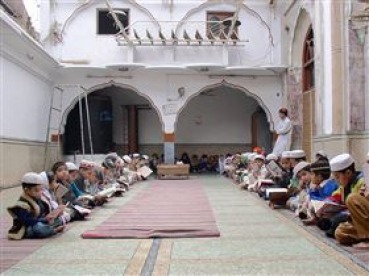The mosque and the Madrasah

The Madrasa (Qur'an School)
This unique type of religious building has long been a part of Islamic civilization. The madrasa, a school for the training of spiritual and legal leaders, became one of the most typical institutions of the Muslim world of the 12th century. Most madrasas were endowed (waqf) with private funds, and these schools' founders frequently established adjoining mausolea.
Egypt and Syria are home to a large number of madrasas. Some of the most noted examples are the great complexes of Sultan Hasan, Qala'un, Barsbay and Qaytbay in Cairo. Constructed from the late 13th century through the 15th century, these madrasas are a blend of social usefulness and private memorialization. As Oleg Grabar writes in The Genius of Arab Civilization, most madrasas are centered on a court with one or more iwans -- large, three-sided, vaulted halls used for teaching. But the most important and visible features of the madrasas typically are their portals and minarets.
Grabar cites the Sultan Hasan madrasa as the most celebrated masterpiece of Cairene architecture. Built in the mid-14th century, the madrasa of Sultan Hasan has a gateway 26 meters high. One of the minarets is at least 82 meters high. The madrasa's most curious feature, writes Grabar, is its design of vertical lines, recessed windows, and bare walls except for a subdued cornice that runs all around the building.
"All these features," Grabar continues, "are strikingly contemporary and may have inspired the American architect Louis Sullivan in his designs of urban commercial buildings in 19th-century America. For, regardless of the specificity of their concerns, the architects of the madrasa of Sultan Hasan developed architectural forms that are universally valid for the functions of a city."
Each one of the four rites of Sunni Islam is represented in this madrasa's functional design. Built around a courtyard are four vaulted halls -- each hall is restricted to one rite. The halls included dwellings (riwaq) for the students and professors. The windows of these rooms are visible on the exterior of the monument.
The founder's tomb has an unusual location. Instead of being placed in a discreet corner, the inordinately large tomb is not only situated on the building's main axis but is in the direction of the qiblah wall which indicates the direction for prayer. Grabar refers to Sultan Hasan as a singularly unimpressive personality. He was made sultan at age 11 and was deposed at age 16. After being reinstalled at age 23, Sultan Hasan was killed at age 26 in the year 1357. It is an interesting twist of fate, Grabar notes, that a weak ruler, murdered in his youth, found the time and support to commission the most magnificent madrasa in Cairo.
(http://www.islamicart.com/main/architecture/madrasah.html).
